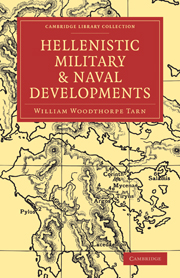Book contents
- Frontmatter
- PREFACE
- Contents
- Lecture I General Outline and Infantry
- Lecture II Cavalry and Elephants
- Lecture III Siege Warfare and Naval Warfare
- Appendix I The number of the Persian Cavalry
- Appendix II The Chinese evidence for the Great War-Horse
- Appendix III Surenas' Camels
- Appendix IV Δίκροτος in a recent papyrus
- Index
Appendix IV - Δίκροτος in a recent papyrus
Published online by Cambridge University Press: 05 October 2010
- Frontmatter
- PREFACE
- Contents
- Lecture I General Outline and Infantry
- Lecture II Cavalry and Elephants
- Lecture III Siege Warfare and Naval Warfare
- Appendix I The number of the Persian Cavalry
- Appendix II The Chinese evidence for the Great War-Horse
- Appendix III Surenas' Camels
- Appendix IV Δίκροτος in a recent papyrus
- Index
Summary
When many years ago I wrote on the “Greek Warship” (J.H.S. 1905, pp. 137, 204), it appeared to me that the key to the understanding of what a trireme was could be found in the word δίκροτος. Given that δίκροτος was a triakontor, there was little difficulty in showing that it meant, not “double-beating,” as had always been assumed, but “double-beaten,” “double-welded” and referred to two horizontal squads of rowers, and consequently that a trireme had three horizontal squads, thranites astern, zugites amidships, thalamites in the bows; for details I must refer back to my paper. The proof however ultimately depended on the equation δίκροτος = triakontor, and that equation was a deduction from some passages in Arrian. It seemed to me, however, an inevitable deduction, and so I think it has turned out; for to-day the equation δίκροτος = triakontor can be based on a simpler foundation.
The papyrus in question is a Ptolemaic papyrus of the first century B.C. from Heracleopolis, and is Nos. 4 and 5 (two parts of one document) of the Heracleopolis papyri, all of the same time, published by W. Kunkel, Archiv für Papyrusforschung, viii, 1927, pp. 169, 190. It deals with the despatch of rations of wheat for a number of ships, which are not at sea, but whose crews are doing liturgies for the dioecetes Athenaeus, and contains a list of ships and their trierarchs; the ration, reckoned in artabae, is for a period of eleven months.
- Type
- Chapter
- Information
- Hellenistic Military and Naval Developments , pp. 162 - 166Publisher: Cambridge University PressPrint publication year: 2010First published in: 1930



